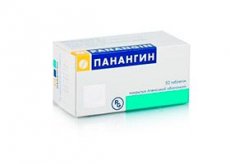Medical expert of the article
New publications
Preparations
Panangin
Last reviewed: 23.04.2024

All iLive content is medically reviewed or fact checked to ensure as much factual accuracy as possible.
We have strict sourcing guidelines and only link to reputable media sites, academic research institutions and, whenever possible, medically peer reviewed studies. Note that the numbers in parentheses ([1], [2], etc.) are clickable links to these studies.
If you feel that any of our content is inaccurate, out-of-date, or otherwise questionable, please select it and press Ctrl + Enter.

Indications Panangin
Among the indications:
- cardiac arrhythmias that arise mainly due to violations of the electrolyte balance (ion composition) - primarily it concerns hypokalemia (that is, a drop in the blood concentration of potassium);
- disorders of the heart rhythm resulting from intoxication with drugs based on digitalis, and in addition because of paroxysms of atrial fibrillation (arrhythmia of the atria) or recently developed ventricular extrasystole (arrhythmia of the ventricles);
- as a means of treating coronary insufficiency (imbalance between the need for oxygen saturation of the heart, as well as its actual delivery).
 [6]
[6]
Pharmacodynamics
The most important cations within the cells (K + and Mg2 +) are the main participants in the processes of functioning of various enzymes, and in addition they help to form the bonds between different macromolecules, as well as structures inside the cells, and contribute to the process of muscle contractility.
The ratio of Ca, calcium ions, Mg and Na outside the cells and inside them affects the contractile function of the myocardium. An aspartate having an external origin is a mediator of ions. It has a significant cellular affinity, and besides this, weak salt dissociation, which allows the ions in the form of complex structures to pass into the cells. Potassium and magnesium aspartates contribute to the improvement of metabolic processes in the myocardium.
Pharmacokinetics
Absorption of the drug occurs fairly quickly. Excretion is carried out through the kidneys.
Dosing and administration
The medicine is consumed orally after ingestion (because in the acidic gastric environment its properties are weakened). Before starting treatment, consultation with your doctor is required.
Dosage is usually 1-2 tablets three times a day. Maximum of 9 tablets per day is allowed per day (3 times per day).
The duration of therapy, as well as the need for a repeat course can only be determined by a doctor.
 [10]
[10]
Use Panangin during pregnancy
In pregnancy, the drug should be administered with great care (especially in the 1st trimester).
Contraindications
Among the contraindications:
- individual intolerance of any component that is part of the drug;
- renal failure in acute or chronic form;
- hyperkalemia or hypermagnia;
- hypokorticism;
- atrioventricular blockade of 1-3 degrees;
- the state of cardiogenic shock (blood pressure index is <90 mm);
- Amino acid metabolism disorder;
- severe myasthenia gravis;
- erythrocytolysis;
- acute form of non-respiratory acidosis;
- dehydration of the body.

Side effects Panangin
There may be such adverse reactions to taking medication:
- vomiting with nausea and diarrhea;
- burning or discomfort in the pancreas (in patients with cholecystitis or an anatomic gastritis);
- AV blockade;
- increase in the number of extrasystoles;
- the development of hyperkalemia or hypermagnesemia (with symptoms such as a feeling of thirst, a decrease in blood pressure, suppression of the respiratory process, redness of the face, hyporeflexia, and the appearance of seizures).
 [9]
[9]
Overdose
Among the manifestations of an overdose: conduction disorder (especially if the patient previously had problems with a conduction cardiac system).
To get rid of these symptoms, a solution of CaCl2 is administered intravenously. If there is such a need, hemodialysis is performed, as well as peritoneal dialysis.

Interactions with other drugs
When combined with potassium-sparing diuretics (such as triamterene, as well as spironolactone), heparin and cyclosporine, and in addition to β-adrenoblockers, ACE inhibitors and NSAIDs, the risk of hyperkalemia increases, which can reach asystole or arrhythmia.
Potassium drugs in conjunction with GCS can eliminate hypokalemia, which is provoked by the latter. The potassium effect weakens the side effects manifested when using cardiac glycosides. In conjunction with Panangin, negative butmotropic properties of antiarrhythmic drugs are enhanced.
Anesthetic drugs increase the strength of the magnesium inhibitory effect on the central nervous system. Due to the combination with such drugs as atrakuroniy, succinyl chloride, decamethonium, as well as suxamethonium, the blockade of the neuromuscular system may increase. When combined with calcitriol, the magnesium plasma concentration increases. Simultaneous use of calcium and magnesium drugs weakens the effectiveness of the latter.
Medications with enveloping and astringent properties reduce the absorption of Panangin in the digestive tract, therefore it is required to observe the interval between the use of these drugs - not less than 3 hours.
Storage conditions
You need to keep the medicine in standard conditions for medicines. The temperature regime of storage should be within 15-30 ° C.

Shelf life
Panangin is allowed to be used within 5 years from the date of manufacture of the drug.
 [14]
[14]
Attention!
To simplify the perception of information, this instruction for use of the drug "Panangin" translated and presented in a special form on the basis of the official instructions for medical use of the drug. Before use read the annotation that came directly to medicines.
Description provided for informational purposes and is not a guide to self-healing. The need for this drug, the purpose of the treatment regimen, methods and dose of the drug is determined solely by the attending physician. Self-medication is dangerous for your health.

